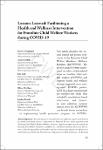Lessons Learned: Facilitating a Health and Wellness Intervention for Frontline Child Welfare Workers during COVID-19
| dc.contributor.author | Haughtigan, K | |
| dc.contributor.author | Griffiths, A | |
| dc.contributor.author | Kim, L | |
| dc.contributor.author | Beer, O | |
| dc.contributor.author | Lindsey, P | |
| dc.date.accessioned | 2024-01-09T10:01:47Z | |
| dc.date.available | 2024-01-09T10:01:47Z | |
| dc.date.issued | 2024-01 | |
| dc.identifier.issn | 0009-4021 | |
| dc.identifier.uri | https://pearl.plymouth.ac.uk/handle/10026.1/21884 | |
| dc.description.abstract |
Child maltreatment is one of the nation’s most significant public health concerns. The estimated annual economic burden of child maltreatment in the United States is more than $292 billion (Peterson et al., 2018). In 2021, approximately four million referrals were made to child protective service agencies alleging the maltreatment of more than seven million children (U.S. Department of Health and Human Services [HHS], 2023). The primary mechanism for evaluating these referrals is the frontline child welfare workforce. Frontline child welfare workers (FCWWs) engage families and make decisions about the safety of children that directly impact children’s futures (Edwards & Wildeman, 2018). High levels of worker turnover, agency understaffing, and an inexperienced workforce constitute a national problem with concerning implications. FCWWs often prematurely leave their positions, with the average tenure being less than two years (Edwards & Wildeman, 2018). Turnover among practitioners is expensive. The estimated fiscal cost to agencies for each practitioner leaving their position is $54,000 (National Child Welfare Workforce Institute, 2016). Further, service delivery, continuity of care, and performance standards are negatively impacted when workers leave their positions (Scannapieco & Connell-Carrick, 2007). | |
| dc.format.extent | 31-51 | |
| dc.publisher | Child Welfare League of America, Inc. | |
| dc.title | Lessons Learned: Facilitating a Health and Wellness Intervention for Frontline Child Welfare Workers during COVID-19 | |
| dc.type | journal-article | |
| dc.type | Article | |
| plymouth.issue | 4 | |
| plymouth.volume | 101 | |
| plymouth.publisher-url | https://www.cwla.org/child-welfare-journal/journal-archives/ | |
| plymouth.publication-status | Published | |
| plymouth.journal | Child welfare | |
| plymouth.organisational-group | |Plymouth | |
| plymouth.organisational-group | |Plymouth|Faculty of Health | |
| plymouth.organisational-group | |Plymouth|Faculty of Health|School of Health Professions | |
| plymouth.organisational-group | |Plymouth|REF 2021 Researchers by UoA | |
| plymouth.organisational-group | |Plymouth|Users by role | |
| plymouth.organisational-group | |Plymouth|Users by role|Academics | |
| plymouth.organisational-group | |Plymouth|REF 2021 Researchers by UoA|UoA20 Social Work and Social Policy | |
| plymouth.organisational-group | |Plymouth|REF 2028 Researchers by UoA | |
| plymouth.organisational-group | |Plymouth|REF 2028 Researchers by UoA|UoA20 Social Work and Social Policy | |
| dcterms.dateAccepted | 2024-01-01 | |
| dc.date.updated | 2024-01-09T10:01:46Z | |
| dc.rights.embargodate | 2024-1-10 |


